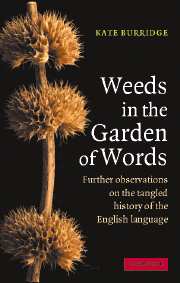Book contents
- Frontmatter
- Contents
- Acknowledgments
- Introduction to the Weedy Traits of the English Language
- Our Lexical Weeds: the World of Jargon, Slang and Euphemism
- More Lexical Weeds: Word Origins and Meaning Shifts
- Our Grammatical Weeds
- Weeds in Our Sounds and Spelling
- The Truly Nasty Weeds of the English Language?
- W(h)ither Our Weeds?
- Bibliography
- List of Interesting Words
The Truly Nasty Weeds of the English Language?
Published online by Cambridge University Press: 22 September 2009
- Frontmatter
- Contents
- Acknowledgments
- Introduction to the Weedy Traits of the English Language
- Our Lexical Weeds: the World of Jargon, Slang and Euphemism
- More Lexical Weeds: Word Origins and Meaning Shifts
- Our Grammatical Weeds
- Weeds in Our Sounds and Spelling
- The Truly Nasty Weeds of the English Language?
- W(h)ither Our Weeds?
- Bibliography
- List of Interesting Words
Summary
The nastiest of all weeds is that sycophant – Dock, called also Herb Patience. When you grasp the strong-smelling stalk it has no fibre, it melts away in a soft squash, leaving its root in the ground; even Nettles are pleasanter to touch.
Anna Lea Merritt An Artist's Garden 1908At the beginning of this book I pointed out what I thought was a problem with my use of weed imagery. Clearly there are noxious plants out there in weed flora that inflict (sometimes irreversible) damage on their environment. Linguistic weeds, I suggested, are pesky but never truly pernicious in this way. In fact, linguists would argue they are an essential part of any thriving language. But perhaps not all linguistic weeds are quite so harmless. I'm thinking in this case of aspects of language that have to do with manipulation through advertising and propaganda, of the influence of language on our thinking and behaviour, of linguistic discrimination and, in particular, of official obfuscation and games of status and power. In this next section I want to expose what look to be some really nasty weeds in our language.
The mind and language – mental illness
Dwight Bolinger, in his book Aspects of Language, describes language as being rather like a pair of spectacles through which we view the world. The problem is, of course, that these particular specs aren't made of clear glass.
- Type
- Chapter
- Information
- Weeds in the Garden of WordsFurther Observations on the Tangled History of the English Language, pp. 165 - 181Publisher: Cambridge University PressPrint publication year: 2005



